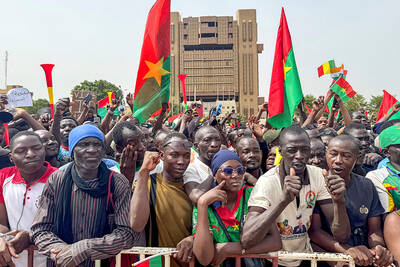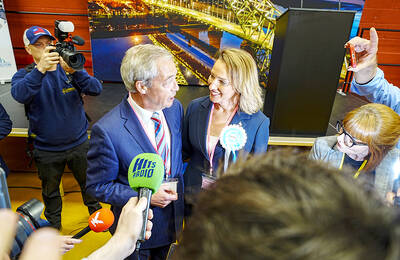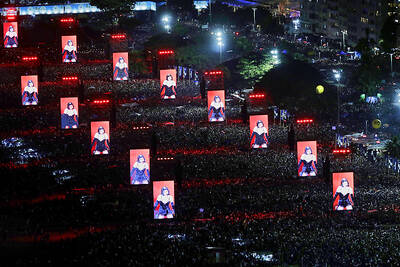Centuries ago Kwanggaet’o the Great ruled over a mighty empire stretching from south of Seoul deep into Manchuria in China’s northeast, but his Koguryo dynasty is now at the center of a historical tug-of-war.
He is revered as a Korean national hero on both sides of the divided peninsula, while Chinese attempts to claim Koguryo as its own have provoked fury among its neighbors.
One of Koguryo’s capitals, now the modern Chinese city of Jian, stands on the Yalu River on the frontier between China and Kim Jong-un’s North Korea. It hosts a treasure trove of historical sites and cultural relics, including royal mausoleums designated as UNESCO World Heritage sites and decorated with murals depicting traditional wrestling and tiger-hunting. A towering stone stele more than 6m tall illustrates the dispute, with Kwanggaet’o’s name carved into the granite — in the classical Chinese characters used for writing in northeast Asia at the time.
“Koguryo is in fact part of Korean history, not Chinese history,” South Korean visitor Hwang Seon-goo said.
“We think that China insists on having its own way,” Hwang added.
Soon afterwards Zhang Ming, who identified himself as a Chinese tourist, expressed keen interest in knowing what the South Korean visitor had said.
In response, he pointed to the language of the inscription as evidence of its Chineseness, asking “how it could be Korean” if it was written in Chinese.
The general Chinese view can be seen in a description in a Jian museum devoted to the dynasty.
“Koguryo was engaged in wars with ancient central China and surrounding nations and tribes,” reads one label.
“However, they finally accepted the authority of ancient central China dynasties and had a main historical trend of tributary kingdom,” it adds.
The sensitivity of the issue is such that a reporter visiting the museum was briefly detained by public security officials, before being ordered to leave Jian and followed out of town.
Koreans on both sides of the divided peninsula claim Koguryo as an inherent part of their history, and it is a popular theme in South Korea for novels and television dramas, such as this year’s The Blade and Petal, a tale of romance and political infighting toward the dynasty’s close.
Koguryo lasted from at least 37 BC until 668 AD, when it was brought down by an alliance between the Chinese Tang Dynasty and Silla, a rival Korean kingdom.
However, the areas governed by the empire, spelled “Goguryeo” in South Korea and “Gaogouli” in China, lie in what today are four modern sovereign states: the two Koreas, China and Russia.
Tensions began rising about a decade ago when China launched what it called the Northeast Project, which was a re-examination of the history of the country’s border areas in the region.
Reaction was particularly negative in South Korea where the move was seen as an attempt to hijack Korean history, and even a possible prelude to Chinese designs on its ally North Korea, were the ruling regime to collapse.
South Korea’s foreign ministry devotes a section of its Web site to the topic, putting it on a par with the row with Japan over the islets in the Sea of Japan (known as the “East Sea” in South Korea), called Dokdo by Seoul and Takeshima by Tokyo.
“The Korean government considers issues concerning the history of Goguryeo to be a matter of national identity, and thus places such issues among its highest priorities,” the Web site says.
In 2006, South Korea’s then-president Roh Moo-hyun reportedly raised the research personally with Wen Jiabao (溫家寶), China’s premier at the time.
Tensions may have eased since, but South Korea still keeps a close eye on “new cases of historical distortion,” according to the foreign ministry.
Adam Cathcart, a lecturer in Chinese history at Britain’s University of Leeds said: “When you look at North Korean relations with China, when you look at South Korean relations with China, it’s an impediment, it’s an irritant, it’s something that all sides are watching.”
Kwanggaet’o, who reigned from 391 to 413 and whose name is often translated as “broad expander of territory,” is known in China as “Haotaiwang.” South Korea spells his name “Gwanggaeto” — and uses it for a class of its warships.
For its part, North Korea — whose government proclaims a “military first” principle — also has numerous sites related to Koguryo and sometimes invokes the dynasty in its propaganda.
“Koguryo martial valor is something that is seen as very desirable from an historical exemplary point of view... for the North Korean leaders,” said Cathcart, an expert in relations between Beijing and Pyongyang.
North Korea’s young leader — who recently had his uncle executed — would undoubtedly want to visit the ancient tombs in Jian, he added.
“That’s a photo op to die for, for Kim Jong-un,” he said.

Kehinde Sanni spends his days smoothing out dents and repainting scratched bumpers in a modest autobody shop in Lagos. He has never left Nigeria, yet he speaks glowingly of Burkina Faso military leader Ibrahim Traore. “Nigeria needs someone like Ibrahim Traore of Burkina Faso. He is doing well for his country,” Sanni said. His admiration is shaped by a steady stream of viral videos, memes and social media posts — many misleading or outright false — portraying Traore as a fearless reformer who defied Western powers and reclaimed his country’s dignity. The Burkinabe strongman swept into power following a coup in September 2022

‘FRAGMENTING’: British politics have for a long time been dominated by the Labor Party and the Tories, but polls suggest that Reform now poses a significant challenge Hard-right upstarts Reform UK snatched a parliamentary seat from British Prime Minister Keir Starmer’s Labor Party yesterday in local elections that dealt a blow to the UK’s two establishment parties. Reform, led by anti-immigrant firebrand Nigel Farage, won the by-election in Runcorn and Helsby in northwest England by just six votes, as it picked up gains in other localities, including one mayoralty. The group’s strong showing continues momentum it built up at last year’s general election and appears to confirm a trend that the UK is entering an era of multi-party politics. “For the movement, for the party it’s a very, very big

ENTERTAINMENT: Rio officials have a history of organizing massive concerts on Copacabana Beach, with Madonna’s show drawing about 1.6 million fans last year Lady Gaga on Saturday night gave a free concert in front of 2 million fans who poured onto Copacabana Beach in Rio de Janeiro for the biggest show of her career. “Tonight, we’re making history... Thank you for making history with me,” Lady Gaga told a screaming crowd. The Mother Monster, as she is known, started the show at about 10:10pm local time with her 2011 song Bloody Mary. Cries of joy rose from the tightly packed fans who sang and danced shoulder-to-shoulder on the vast stretch of sand. Concert organizers said 2.1 million people attended the show. Lady Gaga

SUPPORT: The Australian prime minister promised to back Kyiv against Russia’s invasion, saying: ‘That’s my government’s position. It was yesterday. It still is’ Left-leaning Australian Prime Minister Anthony Albanese yesterday basked in his landslide election win, promising a “disciplined, orderly” government to confront cost-of-living pain and tariff turmoil. People clapped as the 62-year-old and his fiancee, Jodie Haydon, who visited his old inner Sydney haunt, Cafe Italia, surrounded by a crowd of jostling photographers and journalists. Albanese’s Labor Party is on course to win at least 83 seats in the 150-member parliament, partial results showed. Opposition leader Peter Dutton’s conservative Liberal-National coalition had just 38 seats, and other parties 12. Another 17 seats were still in doubt. “We will be a disciplined, orderly